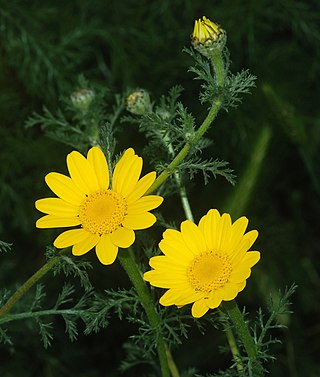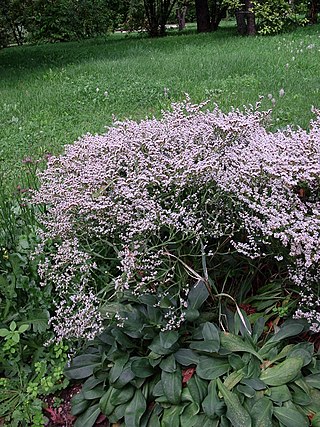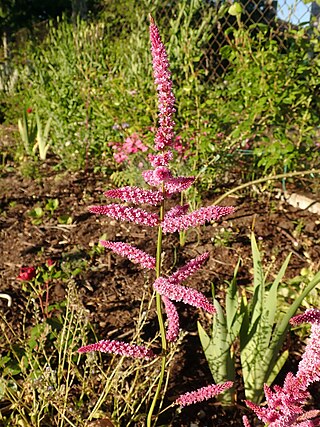
Cota tinctoria, the golden marguerite, yellow chamomile, or oxeye chamomile, is a species of perennial flowering plant in the sunflower family. Other common names include dyer's chamomile, Boston daisy, and Paris daisy. In horticulture this plant is still widely referred to by its synonym Anthemis tinctoria.

Limonium is a genus of about 600 flowering plant species. Members are also known as sea-lavender, statice, caspia or marsh-rosemary. Despite their common names, species are not related to the lavenders or to rosemary. They are instead in Plumbaginaceae, the plumbago or leadwort family. The generic name is from the Latin līmōnion, used by Pliny for a wild plant and is ultimately derived from the Ancient Greek leimon.

Lavandula stoechas, the Spanish lavender or topped lavender (U.S.) or French lavender (U.K.), is a species of flowering plant in the family Lamiaceae, occurring natively in several Mediterranean countries, including France, Spain, Portugal, Italy, Turkey and Greece.

Armeria maritima, the thrift, sea thrift or sea pink, is a species of flowering plant in the family Plumbaginaceae. It is a compact evergreen perennial which grows in low clumps and sends up long stems that support globes of bright pink flowers. In some cases purple, white or red flowers also occur. It is a popular garden flower and has been distributed worldwide as a garden and cut flower. It does well in gardens designed as xeriscapes or rock gardens. The Latin specific epithet maritima means pertaining to the sea or coastal.

Phormium colensoi, also called mountain flax, or wharariki in Māori, is a perennial plant that is endemic to New Zealand. The greenish, yellow or orange flowers are followed by twisted seed pods. It is less common than the other Phormium species, P. tenax or harakeke. Mountain flax is also called whararipi, whatariki, mangaeka, kōrari tuauru, wauraki, coastal flax, hill flax and lesser New Zealand flax.

Limonium sinuatum, commonly known as wavyleaf sea lavender, statice, sea lavender, notch leaf marsh rosemary, sea pink, is a Mediterranean plant species in the family Plumbaginaceae known for its papery flowers that can be used in dried arrangements.

Limonium narbonense is a species of sea lavender belonging to the family Plumbaginaceae.

Goniolimon, sometimes called the statices, are a genus of flowering plants in the leadwort and plumbago family Plumbaginaceae, native to northern Africa, southern Europe, western and central Asia, Siberia, Mongolia and China. Low-lying perennial shrubs, some species are cultivated as ground covers.

Goniolimon tataricum is a species of flowering plant in the genus Goniolimon, family Plumbaginaceae. It is called German statice, Tatarian sea-lavender, Tartarian statice or just statice. It is native to Albania, Algeria, Bulgaria, Greece, Kazakhstan, the North Caucasus, Romania, Southern Russia, Tunisia, Ukraine and the former Yugoslavia. It is planted in gardens as a border and ground cover, and also used in the cut flower industry.

Limonium platyphyllum, the broad-leaved statice, or florist's sea lavender, is a species of flowering plant in the family Plumbaginaceae. It is native to the Black Sea region; Bulgaria, Romania, Ukraine, Crimea, south and east European Russia, and the Caucasus, and it has been introduced to Great Britain. A perennial halophyte 60 to 75 cm tall, it is widely available from commercial suppliers. There are a number of cultivars, including the well-known 'Violetta' which has darker petals.

Limonium minutum, the dwarf statice, is a species of flowering plant in the family Plumbaginaceae, native to the Balearic Islands. A halophyte found in coastal habitats, it is occasionally available from commercial suppliers.

Limonium gmelini, the Siberian statice, is a species of flowering plant in the family Plumbaginaceae, native to east-central and southeastern Europe, Russia, the north Caucasus, Turkey, Iran, Kazakhstan, Kyrgyzstan, parts of Siberia, Xinjiang, and Mongolia. A widespread halophytic species, it is found growing in seeps, meadows, steppes, roadsides, and wastelands, as long as they are saline.

Limonium puberulum, the downy sea lavender, is a species of flowering plant in the family Plumbaginaceae, native to subtropical elevations of Lanzarote in the Canary Islands. It is morphologically similar to but genetically distinct from Limonium bourgeaui.

Limonium bourgeaui is a species of flowering plant in the family Plumbaginaceae, native to Lanzarote and Fuerteventura in the Canary Islands. A herbaceous perennial and subshrub, it is morphologically similar to but genetically distinct from Limonium puberulum.
Limonium sinense is a species of flowering plant in the sea lavender genus Limonium, family Plumbaginaceae, native to coastal China, Taiwan, the Ryukyu Islands, and Vietnam. It is a perennial reaching 60 cm (24 in), found on sandy, salty shales next to the ocean. There are a large number of cultivars, with a wide variety of flower colors, created for the cut flower industry. Wild individuals have flowers with white sepals and yellow petals.

Limonium tetragonum, the square-stalked sea lavender, is a species of flowering plant in the family Plumbaginaceae. It is native to Primorsky Krai in Russia, South Korea, central and southern Japan, the northern Ryukyu Islands, and New Caledonia some 6,800 km (4,200 mi) away. A biennial halophyte, it can be found growing at the high tide line in coastal wetlands and in salt marshes. It is collected in the wild and eaten as a vegetable, and is considered to have medicinal properties. There appears to be an ornamental cultivar, 'Confetti'.
Limonium otolepis, the saltmarsh sea lavender, lacy sea lavender or Asian sea lavender, is a species of flowering plant in the family Plumbaginaceae. It is native to Afghanistan, Central Asia, and Xinjiang and western Gansu in China. A halophyte, it is common in saline areas, such as the bed of the former Aral Sea. It has been introduced to California as a garden escapee, and is also present in southeastern Australia. There appears to be an ornamental cultivar, 'Lavender Lace'.

Psylliostachys suworowii, the poker statice or Russian statice, is a species of flowering plant in the family Plumbaginaceae, native to Central Asia and Afghanistan, and introduced to scattered locales worldwide. An annual typically 50 cm (20 in) tall, it is widely cultivated as an ornamental.
Limonium cosyrense is a species of flowering plant in the family Plumbaginaceae, native to Malta and Pantelleria. It is occasionally available from commercial suppliers.
















